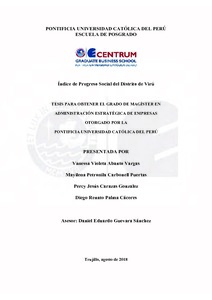| dc.contributor.advisor | Guevara Sánchez, Daniel Eduardo | |
| dc.contributor.author | Abanto Vargas, Vanessa Violeta | es_ES |
| dc.contributor.author | Carbonell Puertas, Mayilena Petronila | es_ES |
| dc.contributor.author | Carazas Gonzalez, Percy Jesús | es_ES |
| dc.contributor.author | Palma Cáceres, Diego Renato | es_ES |
| dc.date.accessioned | 2018-09-23T20:50:01Z | |
| dc.date.available | 2018-09-23T20:50:01Z | |
| dc.date.created | 2018 | |
| dc.date.issued | 2018-09-23 | |
| dc.identifier.uri | http://hdl.handle.net/20.500.12404/12718 | |
| dc.description.abstract | El producto bruto interno per cápita es considerado hoy el principal indicador
económico que mide el desarrollo de los países; sin embargo, este indicador no representa
plenamente el nivel de satisfacción de las necesidades de la población. Es por ello que nace el
Índice de Progreso Social (IPS) desarrollado por el Social Progress Imperative, el cual cuenta
tres dimensiones: (a) Necesidades Humanas Básicas, (b) Fundamentos del Bienestar, y (c)
Oportunidades, integradas cada una de ellas por cuatro componentes. Este índice tiene como
objetivo medir los resultados de la aplicación de las políticas gubernamentales orientadas a la
satisfacción de estas necesidades.
Bajo esta metodología, se calculó el IPS del distrito de Virú, arrojando como resultado
57.20 y ubicándose en un rango de calificación “Medio bajo”, rango que además es
compartido por las tres dimensiones del índice; debemos precisar que, dentro de las
dimensiones, existen tres componentes que han alcanzado una calificación mayor al rango
promedio (entre “Medio alto”, y “Alto”) y cinco que se encuentran dentro de un rango menor
al promedio (entre “Muy bajo” y “Extremo Bajo); los cuales son analizados frente al Plan de
Desarrollo Concertado del Municipio y otros instrumentos de gobierno. Algunos de estos
compontes se encuentran incluidos de manera directa, con planes de acción e indicadores de
medición, mientras que otros no han sido considerados.
Asimismo, para la realización del presente estudio, dividimos al distrito en dos
sectores que fueron determinados de acuerdo a su ubicación geográfica, tomando como punto
de referencia el corte efectuado por el paso de la carretera panamericana; siendo que el sector
1 (lado este) obtuvo un IPS de 58.95, rango “Medio bajo”; mientras que el sector 2 (lado
oeste) arrojó un IPS de 50.07, rango “Bajo”. Esta diferencia determina distintas carencias
para cada sector, así como diferentes oportunidades de mejora que la gestión gubernamental
deberá tomar en consideración para la elaboración de sus planes de acción. | es_ES |
| dc.description.abstract | Nowadays, the Gross Domestic Product per capita is considered the main economic
indicator that measures the development of the countries. However, this indicator does not
totally fully describe the unmet needs of the population. That is why the Social Progress
Index (SPI) developed by the Social Progress Imperative is born, which has three dimensions:
(a) Basic human needs, (b) Fundamentals of well-being and (c) Opportunities, each one also
integrated by four components; The purpose of this indicator is to measure the results of
government policies application oriented to the satisfaction of this needs.
Under this methodology, the IPS of the district of Virú was calculated, getting a result
of 57.20 and placing itself in a "Medium Low" rating range, a range that is also shared by the
three dimensions of the index; we must specify that, within the dimensions, there are three
components that have achieved a higher rating than the average range (between "Medium
High", and "High") and five that are within a lower than average range (between "Very low"
"And" Extreme Low); which are analyzed against the Concerted Development Plan of the
Municipality and other government instruments. Some of these components are included
directly, with action plans and measurement indicators, while others have not been
considered.
Likewise, in order to make this investigation, we divided the district into two sectors
that were determined according to their geographical location, taking as a point of reference
the cut made by the passage of the Pan-American highway; being that sector 1 (east side)
obtained an SPI of 58.95, "medium low" range; while sector 2 (west side) showed an SPI of
50.07, "Low" range. This difference determines different deficiencies for each sector as well
as different opportunities for improvement that government management should take into
consideration for the preparation of their action plans. | es_ES |
| dc.language.iso | spa | es_ES |
| dc.publisher | Pontificia Universidad Católica del Perú | es_ES |
| dc.rights | info:eu-repo/semantics/openAccess | es_ES |
| dc.rights.uri | http://creativecommons.org/licenses/by-nc-nd/2.5/pe/ | * |
| dc.subject | Indicadores sociales--Perú--Virú (La Libertad : Provincia) | es_ES |
| dc.subject | Indicadores económicos--Perú--Virú (La Libertad : Provincia) | es_ES |
| dc.subject | Investigación cuantitativa | es_ES |
| dc.title | Índice de progreso social del distrito de Virú | es_ES |
| dc.type | info:eu-repo/semantics/masterThesis | es_ES |
| thesis.degree.name | Maestro en Administración Estratégica de Empresas | es_ES |
| thesis.degree.level | Maestría | es_ES |
| thesis.degree.grantor | Pontificia Universidad Católica del Perú. CENTRUM | es_ES |
| thesis.degree.discipline | Administración Estratégica de Empresas | es_ES |
| renati.discipline | 413307 | es_ES |
| renati.level | https://purl.org/pe-repo/renati/level#maestro | es_ES |
| renati.type | https://purl.org/pe-repo/renati/type#tesis | es_ES |
| dc.publisher.country | PE | es_ES |
| dc.subject.ocde | https://purl.org/pe-repo/ocde/ford#5.02.04 | es_ES |






